ICD-Code C72.8: Malignant neoplasm: Overlapping lesion of brain and other parts of central nervous system
You have cancer of the brain or spinal cord.
The tissue in the body is made up of cells. With cancer, the cells multiply uncontrollably, which leads to a malignant neoplasm (abnormal growth of tissue) developing. The cancer cells can destroy the healthy tissue and spread throughout the body.
The brain is made up of several areas. For example, the cerebrum is used to think and plan actions. In the cerebellum, movements are initialized and coordinated. The brain stem is responsible for various unconscious tasks such as breathing. The brain stem passes into the spinal cord. The spinal cord is located in the spinal column. The spinal cord is made up of nerve fibers. The brain uses the nerve fibers to exchange information with the organs, skin and muscles.
Not every cancer is the same. There are cancers that develop quickly. You may then quickly feel seriously ill. But there are also cancers that progress slowly. You may then feel generally unwell or weak, or even have no symptoms at all to start with. If you have cancer of the brain or spinal cord, you can no longer move certain muscles, for example. You may also behave differently than you normally would or have seizures. These seizures may only affect one part of the body. A seizure may also occur without cramp. Then you are passed out for a short time.
Please note: This ICD code may also derive from the ICD-O system. If this is the case, there are usually additional letters and numbers in addition to the code. It starts with the letter M, followed by 4 digits and then a slash. There is another digit after the slash.
If it is an ICD-O code, then this does not describe a malignant cancer in all cases. The last digit after the slash gives you more detailed information about this:
- /0 – The tumor is benign. Cells in a tissue multiply uncontrollably. However, they are not destroying the surrounding tissue and are also not spreading throughout the body.
- /1 – It is not known for sure whether the tumor is benign or malignant.
- /2 – It is an early form of cancer, a precancerous stage where the cells are altered and multiply uncontrollably. However, they are not yet spreading beyond a certain margin and cannot spread to other organs either.
- /3 – It is a malignant cancer. The cells in the affected tissue are altered and multiply uncontrollably. They can destroy the surrounding tissue and spread throughout the body.
- /6 – It is a metastasis. Cancer cells have spread from the originally affected site to a different site in the body and have further multiplied there.
- /9 – It is either a malignant cancer or a metastasis. The cells in the affected tissue are altered and multiply uncontrollably. However, it is impossible to say whether these cells derive originally from the affected site or have spread there from a different site in the body.
Additional indicator
On medical documents, the ICD code is often appended by letters that indicate the diagnostic certainty or the affected side of the body.
- G: Confirmed diagnosis
- V: Tentative diagnosis
- Z: Condition after
- A: Excluded diagnosis
- L: Left
- R: Right
- B: Both sides
Further information
Source
Provided by the non-profit organization “Was hab’ ich?” gemeinnützige GmbH on behalf of the Federal Ministry of Health (BMG).



